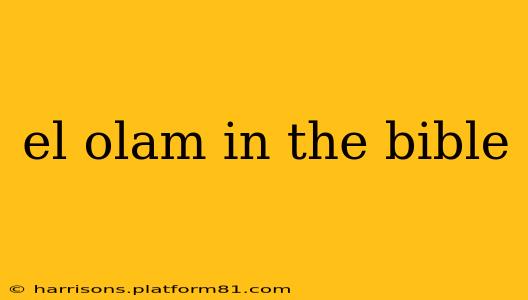The Hebrew word עולם (olam) appears frequently throughout the Hebrew Bible (Tanakh), carrying a rich and multifaceted meaning that extends beyond a simple translation of "world." Understanding its nuances is crucial for comprehending the biblical narrative and theological concepts. While often translated as "world," "age," or "eternity," olam encompasses a deeper semantic range reflecting the ancient Hebrew worldview. This exploration delves into the various contexts of olam, aiming to provide a comprehensive understanding of its significance.
What does Olam mean in the Bible?
The core meaning of olam resists a single, definitive translation. It signifies a duration of time, but the nature of that duration varies greatly depending on context. It can refer to:
-
A long period of time: This is often the case when olam describes historical eras or epochs. Think of phrases like "from olam to olam," signifying from the beginning of time to its end, or a vast, unspecified duration.
-
The present age or world: This usage is common, referencing the current state of affairs, often in contrast to a future, messianic age.
-
Eternity: This is arguably the most profound meaning of olam, referring to the timeless existence of God and the everlasting nature of His promises. In this context, olam signifies something without beginning or end.
What is the difference between Olam and Tevel?
This is a crucial distinction. While both terms relate to "world," they offer different perspectives:
-
Olam (עולם): Emphasizes the duration and the totality of existence, both temporal and eternal aspects. It's a broader, more encompassing term.
-
Tevel (תבל): Often refers to the physical earth or the inhabited world. It's a more concrete, geographically defined term, often focusing on the earthly realm.
How is Olam used in different biblical contexts?
Olam's usage varies across the Old Testament, influencing the overall meaning. Consider these examples:
-
Genesis 1:1: "In the beginning God created the heavens and the earth." Here, the implied sense of "olam" suggests an immeasurable past, an origin beyond human comprehension.
-
Psalm 90:2: "Before the mountains were brought forth, or ever you had formed the earth and the world, from everlasting to everlasting you are God." Here, olam highlights God's eternal existence, preceding and transcending all creation.
-
Isaiah 55:13: "Instead of the thorn shall come up the fir tree, and instead of the brier shall come up the myrtle tree: and it shall be to the Lord for a name, for an everlasting sign that shall not be cut off." Here, "everlasting" (olam) refers to the permanence of God's promises.
-
Daniel 7:18: “But the saints of the Most High shall receive the kingdom, and possess the kingdom for ever and ever, even for ever and ever.” Again, 'ever and ever' reflects the enduring nature of God's kingdom, reflecting the eternal aspect of olam.
What is the meaning of "Olam Ha-Ba" (עולם הבא)?
"Olam Ha-Ba," often translated as "the World to Come," represents a central concept in Jewish theology. It describes a future state of existence, characterized by:
- Perfect Righteousness: A world free from suffering, injustice, and sin.
- Divine Presence: A heightened sense of God's presence and interaction with humanity.
- Messianic Era: Often associated with the coming of the Messiah and the establishment of a utopian society.
The precise nature of Olam Ha-Ba is a matter of ongoing discussion within Jewish thought, with varying interpretations.
What does Olam Hazeh (עולם הזה) mean?
In contrast to Olam Ha-Ba, "Olam Hazeh" means "this world," "this age," or "the present world." It represents the current state of existence, with its imperfections, challenges, and limitations. It's often viewed as a temporary stage, preparing for the ultimate reality of Olam Ha-Ba.
By understanding the multifaceted nature of עולם (olam), we gain a deeper appreciation for the richness and complexity of the biblical text. Its usage transcends simple definitions, revealing the ancient Hebrews' understanding of time, eternity, and the relationship between the present and future realities. The ongoing theological discussions surrounding olam, particularly its connection to Olam Ha-Ba and Olam Hazeh, continue to inform and shape religious understanding today.
